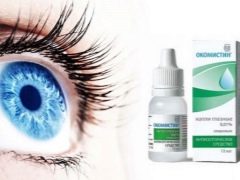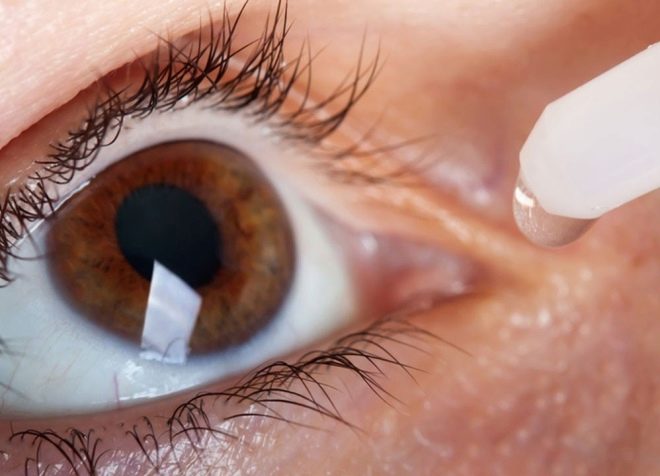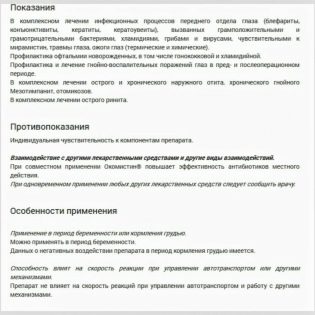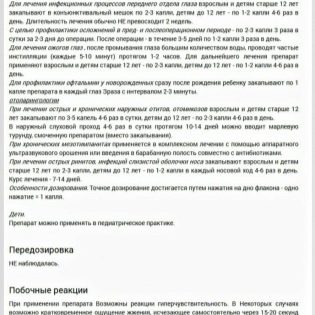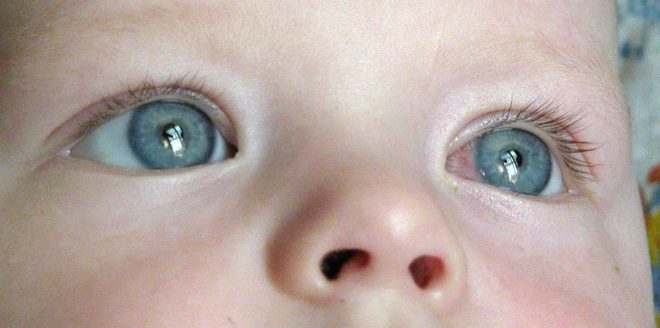"Okomistin" for children: instructions for use
For eye diseases, doctors usually prescribe local remedies that can kill the bacteria and reduce the inflammatory process. One of them is the drug company "Infamed" called "Okomistin." Many studies and practices of ophthalmologists have confirmed its effectiveness in eye injuries, conjunctivitis, eye surgeries and diseases of the upper respiratory tract.
Release form and composition
"Okomistin" is a clear solution without any color, which is usually used as eye drops. It can also serve as ear and nasal drops. It is sold in plastic disposable tubes, droppers of 1 or 1.5 ml each, in plastic bottles with a dropper-tube of 5 and 10 ml, as well as in glass bottles of 20 ml. In one box is 5-10 tubes, droppers, or 1-5 bottles.
The action of the droplets is due to a substance called benzyldimethyl 3-myristoylamino-propyl ammonium. It is also known by another name - “Miramistin”. Its amount in 100 ml of solution is 0.01 g. Sodium chloride and purified water act as auxiliary ingredients of the medication. There are no other compounds, including preservatives or dyes, as part of Okomistin.
Operating principle
The main component of the drug is active against a large number of infectious agents, including not only harmful bacteria, but also protozoa, fungi, and various viruses. Due to this range of effects, Okomistin refers to antiseptics. The solution also has anti-inflammatory effects, enhances local immunity and activates tissue regeneration. At the same time, it does not penetrate into the bloodstream, therefore, the therapeutic effect of Okomistin is exclusively local.
Indications
The most common reason for the use of "Okomistina" are inflammatory diseases of the organ of vision. Such a solution is prescribed for conjunctivitis and keratitis, as well as keratouveitis and blepharitis. In addition to the inflammatory process in the tissues of the eye, Okomistin is in demand in such situations:
- if the child has undergone an eye surgery or is preparing for it (the solution will reduce the risk of complications);
- if the kid has injured eyes;
- if a child has a chemical or thermal eye burn.
“Okomistin” is also used by ENT doctors, prescribing such drops to patients with sinusitis, rhinitis, bacterial otitis and otomycosis.
From what age is prescribed?
The drug can be used both for adolescents and students, and for very young children. There is no age limit for the use of Okomistin. Such a solution can be dripped even to a newborn baby to prevent eye infection caused by gonococci, chlamydia and other pathogens.
Contraindications
The drug is not prescribed only in case of hypersensitivity to its active ingredient. Other contraindications for such a solution is not noted.
Side effects
The manufacturer calls "Okomistin" safe and harmless tool that does not provoke pain, burning and irritation of the mucous membrane. In addition, the solution practically does not cause allergies. Only in rare cases, the children's body reacts to the drug by an allergic reaction, in which it must be canceled.
Instructions for use
"Okomistin" is used topically to treat the mucous membrane of the eyes or nose, and also drips into the ears. At the same time one bottle should be used only for one inflamed area, that is, you should not drip the product from one package into the eyes and at the same time into the ears. In addition, it is not recommended to use one Okomistin package for the treatment of several patients. To prevent the contents of the bottle from becoming contaminated, do not touch the packaging spout to the skin or the surface of the eyes.
The dosage and treatment regimen differ depending on the indication.
- To the newborn, the solution is dripped one drop immediately after birth into each eye. The treatment is repeated three times with intervals of 2-3 minutes.
- If “Okomistin” is prescribed for conjunctivitis or another infectious eye disease, then the solution should be injected into each conjunctival sac one or two drops 4-6 times a day. The medication is used until the symptoms of inflammation disappear, but most often the treatment lasts 7-10 days.
- For the prevention of complications in the surgical treatment of the drug drip 2-3 days before the operation and some time after the intervention (10 days or longer). A single prophylactic dose of Okomistin is 1-2 drops of the solution. The frequency of application - three times a day.
- If there is a burn of the eye, then first it should be washed with plenty of water, then for the first two hours, “Okomistin” drip every 5-10 minutes. Then move on to the application of 1-2 drops from 4 to 6 times during the day until complete healing.
- For the treatment of rhinitis or sinusitis drug drip into the nose 4-6 times a day. In every nasal passage injected 1-2 drops of medicine. The duration of such treatment is up to two weeks.
- If a child has an ear infection, then Okomistin is injected four times a day into the ear canal. The product can be dripped (single dosage - 2-3 drops) or applied to a cotton swab and inserted into the ear. The course of treatment of otitis such an antiseptic lasts up to 10 days.
In the absence of improvement, after 2-3 days of use of Okomistin, a second examination of the doctor is required and the replacement of this medication with another treatment.
Overdose and drug interactions
Excess dose "Okomistina" has no adverse effect and does not require treatment. The combined use of such a solution with topical antibiotics enhances their therapeutic effects. The effect of the drug on other drugs has not been studied.
Terms of sale and storage
To buy "Okomistina" in a pharmacy need a prescription from a doctor. The average price of 10 ml of medicine is 160 rubles. Store the drug at home, if it is not opened, can be 3 years from the date of manufacture. After the first use of the solution is allowed only one month. The recommended storage temperature of the drug is below +25 degrees.
Reviews
Most reviews about Okomistina are positive. They call the drug effective, harmless and inexpensive. Among its advantages are the possibility of use for infants, the absence of side effects and convenient packaging. One of the drawbacks of the drug is considered non-durable storage after opening. Mothers do not call other defects "Okomistina".
Analogs
If “Okomistina” was not in the pharmacy, then instead of it you can use “Miramistin”, because this antiseptic contains the same active compound and is produced by the same company, but in a different package. It can be used not only for various eye diseases, but also in the treatment of pharyngitis, otitis, burns, dermatitis, adenoids, rhinitis, and other pathologies.
In addition, in case of eye diseases, the doctor may replace “Okomistin” with other drops, which act in a similar way, but include other active substances. These include several drugs.
- "Vitabact". The effect of such drops on pathogenic microorganisms causes chikloksidin. Children are prescribed from birth.
- "Signitz". This medicine contains levofloxacin and belongs to the fluoroquinolones. It is prescribed for infected children over 1 year old.
- "Sulfacyl sodium". This sulfa drug is used for infections of the eye and for their prevention. It is used even for newborn babies.
On how to bury eye drops for children, see the following video.
